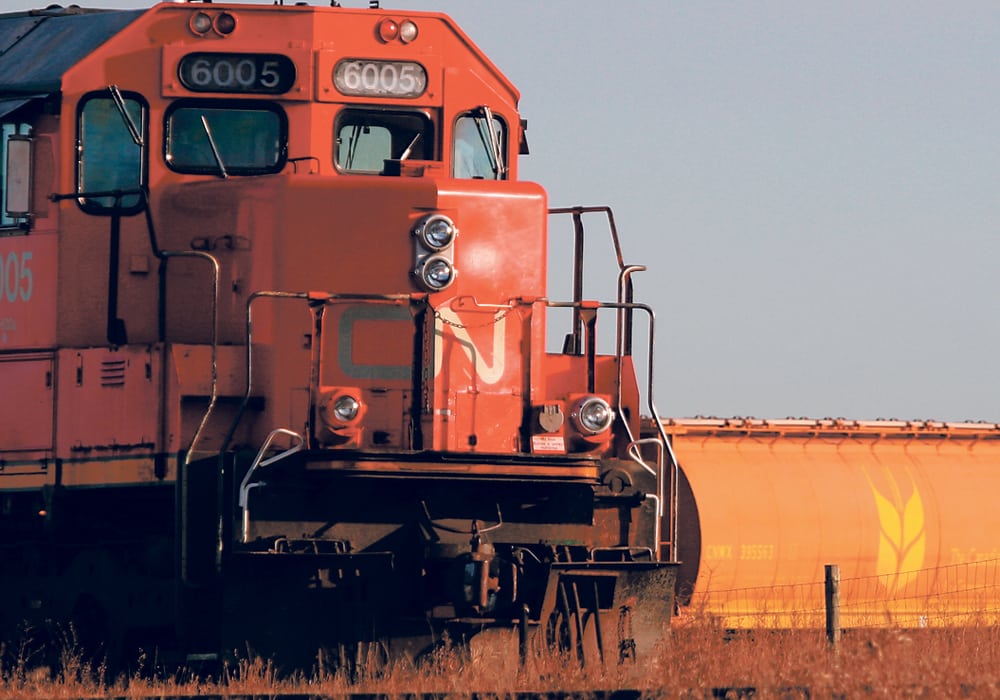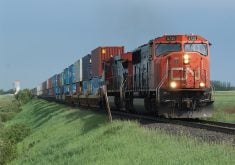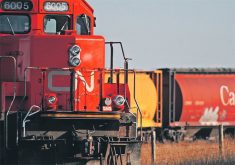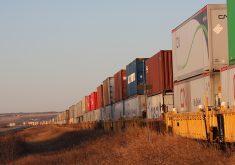Canadian National Railway’s purchase of 1,000 new grain hopper cars represents the first tangible results of Bill C-49 and a major step forward in fleet renewal, say industry observers.
The company announced May 24, the day the transportation modernization act received royal assent after a year of political back-and-forth and hard industry lobbying, that it would buy the Canadian-made high-cube cars over two years.
A cost wasn’t released, but some have pegged it at about $100 million.
Steve Pratte, policy manager at the Canadian Canola Growers Association, has studied hopper fleet renewal for several years. He said car purchase was a “sleeper issue” during the year-long C-49 debate.
Read Also

Farming Smarter receives financial boost from Alberta government for potato research
Farming Smarter near Lethbridge got a boost to its research equipment, thanks to the Alberta government’s increase in funding for research associations.
“This is huge,” he said. “This is analogous to going from the wooden crib (elevator) to a high throughput.”
CN had said it wouldn’t buy the cars unless C-49 passed without amendments. Pratte and others have said that was simply a political tactic. It was essentially an empty threat given the timing of the purchase announcement.
CN vice-president Sean Finn said the amendments the House of Commons accepted from the Senate maintained the bill’s balance between railways and shippers and that made it acceptable to the company.
“We’re comfortable that it provides a stable regulatory environment that allows us to invest in the network for the long term,” he said in an interview.
Amendments that would have impacted the company’s capability to invest weren’t passed, he said.
The key change was allowing each railway’s investment to count toward its own Maximum Revenue Entitlement calculation only, rather than to both railways.
CN and Canadian Pacific Railway share the approximately 8,400 aging federal hopper cars due for replacement. The government has been clear it will not be purchasing new cars.
CP hasn’t yet made a firm public announcement but has said for the past year it is considering a capital plan to replace its entire government fleet.
In an emailed statement the company said changes to the MRE will promote new hopper car investment.
“CP stands ready to make over a $500 million investment over the next several years in new cars which will increase the overall hauling capacity per car in our fleet,” said spokesperson Andy Cummings.
Pratte said if this happens, along with CN’s investment, it could lead to a carrying capacity increase of between 10 and 25 percent.
The total number of cars available then becomes less important.
There are between 22,000 and 24,000 cars in circulation. They include the federal cars, some still owned by provinces, others owned by the railways, grain companies, and private companies and leased cars such as canola oil tankers.
Cycle times have decreased so much over the past few years that a smaller number of larger cars will work, Pratte said.
CN’s new cars, to be manufactured at National Steel Car Ltd. in Hamilton, Ont., will carry 10 percent more grain than the existing cars.
The 55-foot eight-inch jumbo hopper cars have a capacity of 5,431 cubic feet and will allow older, smaller cars to be phased out of service.
Pratte said this leads to more efficiencies throughout the supply chain, such as operations at grain terminals.
Western Grain Elevators Association executive director Wade Sobkowich said industry will be watching to see how CN incorporates the new cars. He said if the company uses the capacity advantage to retire more cars, keep fewer locomotives and crews, and run fewer trains, then there is no gain.
“One positive for certain is that the new cars will be in better condition than the old federal hopper car fleet,” he said.
Grain elevator workers are always repairing gates and hatches to be able to load those cars, he said. Cars that can’t be fixed are considered a “bad order”.
“If an elevator has to bad order three or four cars in a 100-car unit train that is three or four cars of canola (or whatever) that is not making it to the vessel,” he said in an email.
Rail analyst Malcolm Cairns said hopper car investment is one of the definite positives of Bill C-49.
But he still wonders how the railways will fare during demand peaks and winter weather and whether the bill’s requirements for railway transparency will make the system better.
“I don’t think giving shippers railway information will make this better,” he said of grain backlogs at certain times. “The railways know, and yet they still mess up.”
But Finn said he is confident CN will be ready for the fall.
Sixty of the 200 locomotives the company has purchased will be on the tracks in June and more details of capital improvements in the Edmonton-to-Winnipeg corridor are expected soon.
“We want that to be ready for this fall’s grain crop as much as possible,” Finn said. “We have to arrive in the next grain season better prepared and we will be.”
Pratte added that he doesn’t expect an expenditure of $100 million to significantly impact freight costs for farmers.


















